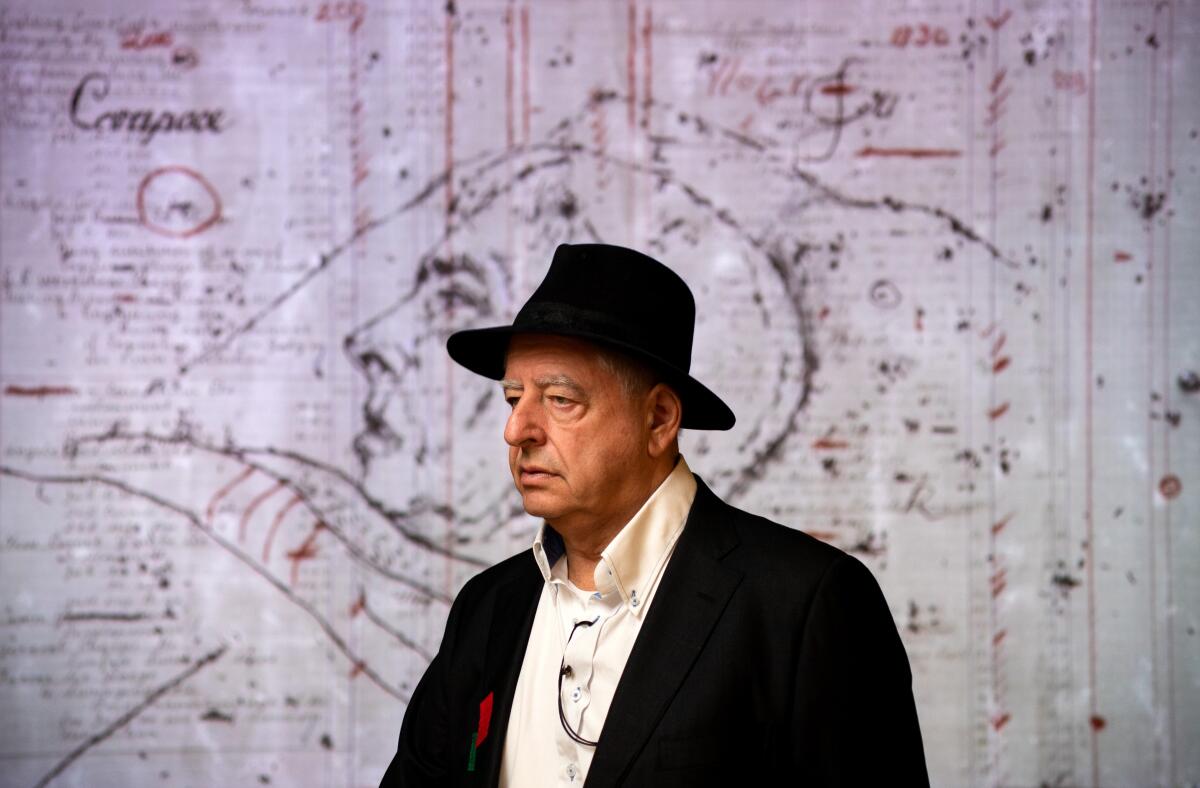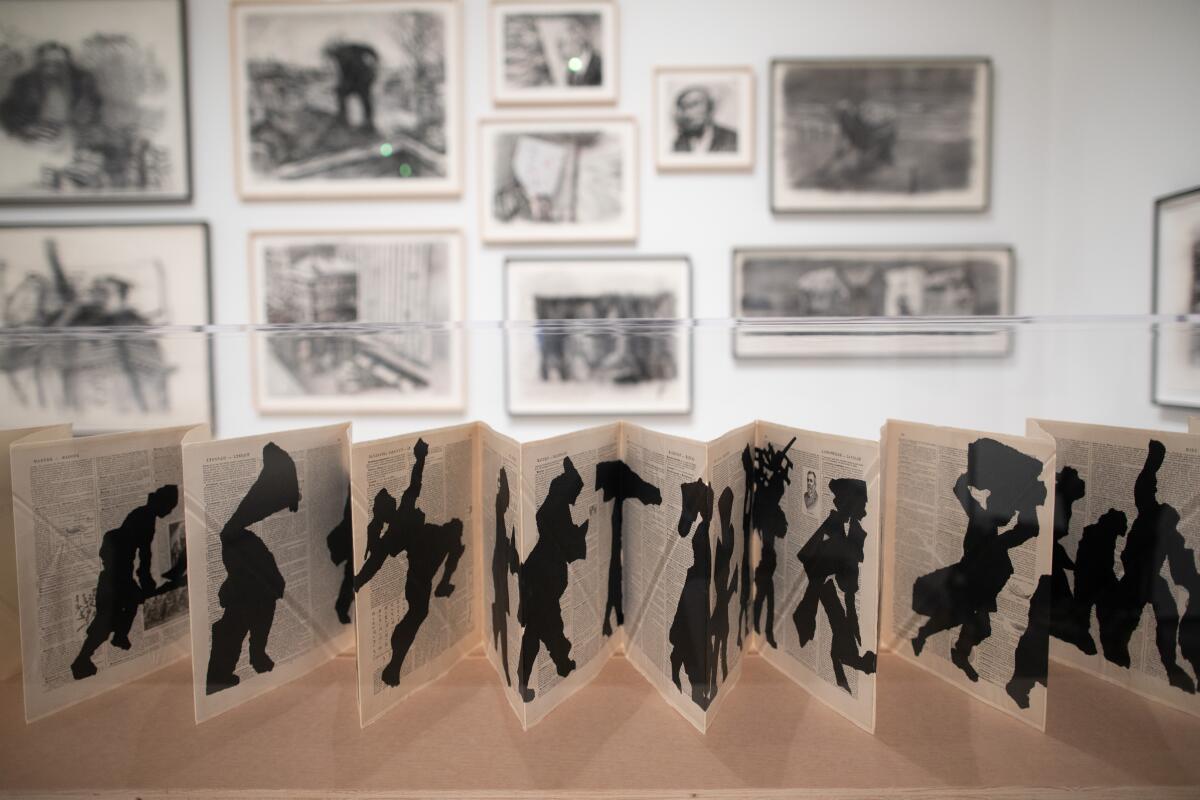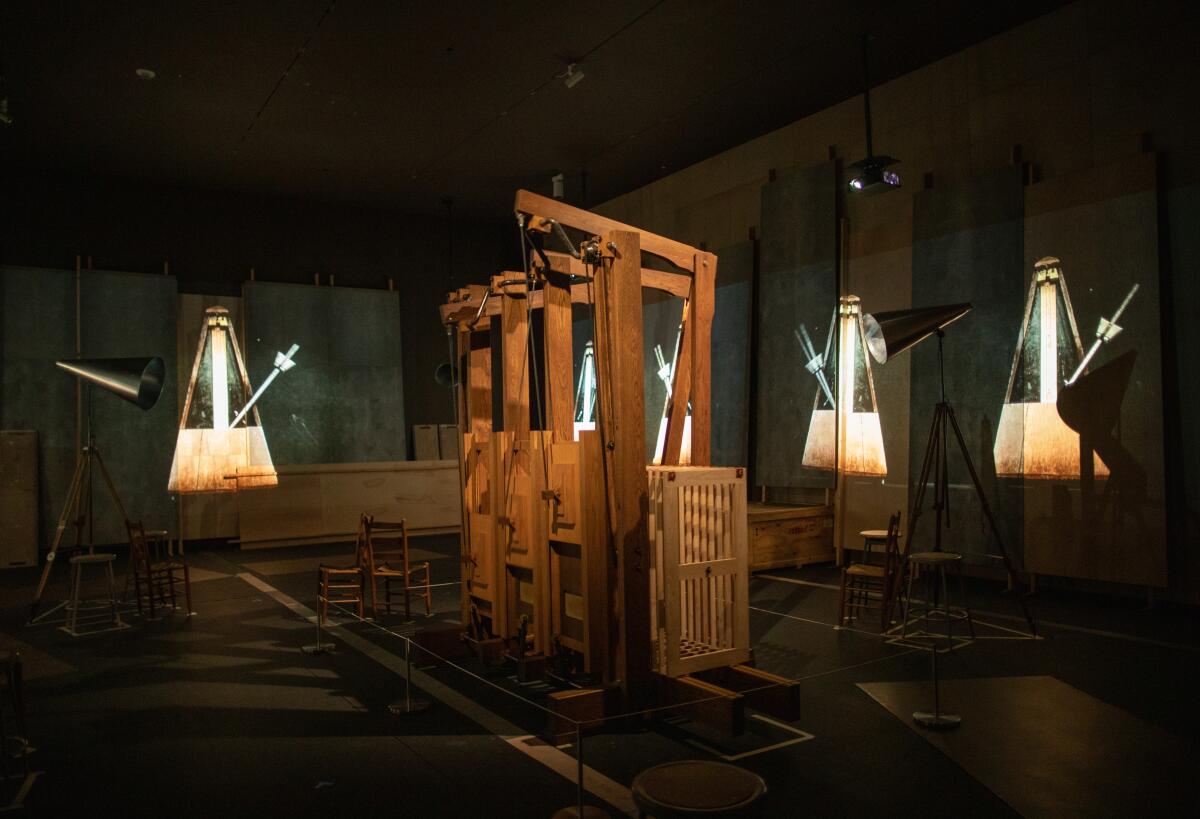Why artist William Kentridge is embracing shadows in his new Broad show

- Share via
In his 2013 video “Second-Hand Reading,” South African artist William Kentridge appears as if walking across the pages of a dictionary. Beside him, as he makes this contemplative passage, words in black block letters briefly overlay the alphabetic entries: “WHICHEVER PAGE YOU OPEN,/THERE YOU ARE.”
It’s classic Kentridge — the artist tweaking scale and space to physically occupy an authoritative text, both locating and implicating himself within. His work over the last four decades has been an ongoing, material-driven inquiry into how we make sense of the world, visually, intellectually and emotionally, how we come to understand what presents itself as fact, and as history. Through drawing, printmaking, collage, hand-drawn animation, tapestry, installation, sculpture, opera and theater, Kentridge dismantles stories and assumptions, reassembling them with the newly conspicuous glue of personal and collective responsibility.
His coupling of accretive intelligence and on-the-spot, real-time generation of form is part of what sustains the artist’s relevance, says Ed Schad, curator of “William Kentridge: In Praise of Shadows,” which opened recently at the Broad.
“The way that art is made right now, there is always an effort for the artwork not to be fully disclosed, not to be sealed by its own form. There is an emphasis on improvisation and keeping meaning moving, not fully defined,” Schad says. “William’s work is a revelation on that front. It’s a road map to how a studio can function and how an artist can think through substantial social issues and bigger historical narratives without being didactic.”

Born in 1955 in Johannesburg, where he lives and works, Kentridge has exhibited at major venues internationally and received an array of notable honors, including the Kyoto Prize and the Carnegie Prize, as well as numerous honorary doctorates. He has mounted productions at the Sydney Opera House, New National Theater Tokyo, Teatro Dell’Opera in Rome, New York’s Metropolitan Opera and more.
It’s been 20 years since his last sizable show in Los Angeles, however, and visitors to the Broad might be experiencing their first — or first comprehensive — encounter with the artist’s work. “In Praise of Shadows” is a feast of an introduction, with roughly 130 works dating from 1975 to 2020. His signature “Drawings for Projection,” short animated films in which charcoal figures and scenes are continually erased and redrawn, are complemented by a full range of work in other media, from a collaged diagram of the meandering loops the artist traces in the studio as he releases thought through movement, to a trio of manual sewing machines affixed with turning loudspeakers that periodically emit song.
Many of the works come from the the Broad’s own collection, including “The Refusal of Time” (2012), an immersive, gloriously unwieldy, five-channel video installation in a large room invoking a workshop or laboratory, where experimentation happens, and stuff — like how time operates — is ever in the messy process of getting figured out. A large wooden-ribbed device sits in the heart of the space, a breathing machine whose steady, open-and-close rhythm is countered by the layered, asynchronous images and sounds all around it, making their case against linearity, order and standardization.

In 2016, Kentridge co-founded the Centre for the Less Good Idea, a Johannesburg space for the incubation of collaborative art and performance. Shortly after the opening of the Broad exhibition, the Centre’s production of “Houseboy” by Ferdinand Oyono, directed by Kentridge, premiered at REDCAT. Based on a 1956 novel, “Houseboy” adopts the intimate form of a young man’s diary to tell of the brutal power imbalances and racial oppression in colonial Cameroon.
South Africa’s own physical and political landscape suffuses Kentridge’s work, which has evolved in tandem with the ongoing, essential, imperfect dismantling of apartheid. But the work has never been solely about South Africa, as “Houseboy” and the breadth of the Broad show demonstrate. Following the lead of Dadaists a century ago, Kentridge confronts an inexplicably mad world with his own robust commitment to absurdity, doubt and fearless reinvention.
Looking the everyman in his uniform of black slacks and white dress shirt — fedora near at hand — Kentridge spoke with The Times in the Broad’s offices a few days before the public opening of his show.
This exhibition, “In Praise of Shadows,” borrows its title from a book on Japanese aesthetics by Junichiro Tanizaki. Your attention to the indeterminate and obscured brings to mind another source, the poet Paul Celan, who wrote: “Speaks true who speaks shadows.” What is it about shadows that captivates you?
In Western philosophy, shadows are to be avoided. The whole trajectory of life is to move out of the shadows, out of darkness, into the light. In Plato’s metaphor of the cave and the whole Enlightenment project, the metaphor is one of light dispelling darkness. The colonial justification to itself is one of bringing light to the dark continents. In fact, we need a kind of darkness and a mixture to make sense of the world.
The title has to do with knowing how little we see when we see a shadow. When you see an actual object, you assume you’re seeing everything about the object. When you see a shadow, you understand you’re seeing a very limited part and you have to fill in the rest yourself. You immediately become complicit in making the meaning.
Provisionality, incompleteness and unknowing are so fundamental to your work. It can read as a kind of paean to the uncertain.
I can’t see how anybody can speak with complete certainty without understanding the aggression in that certainty. One thinks of the 20th century and the cataclysmic disasters brought about by people who have been certain of their plans for their country, how they will rescue humanity, or how the world should be organized — the Khmer Rouge, Mao’s China, Germany. All of these certainties have brought calamity because at a certain point the certainty can only be bolstered with an army of soldiers pointing guns at the populace.
The certainty of optimism, of writers in the 1920s, for instance, also feels completely impossible now. If we can’t have those certainties, how do we operate? By looking for much more local, particular solutions, from the margins. Keeping a position of openness and doubt all the way through.
The Centre for the Less Good Idea seems to bear, in its very name, that humility and receptivity you’re talking about.
The title comes from a Tswana proverb: If the good doctor can’t cure you, find the less good doctor. When the grand ideas don’t work, you’ve got to find other ideas at the edges, at the sides — which has a political element to it, but primarily it’s strategic. It’s about ways of making work.
One often starts with the idea, which we call a good idea, but actually putting it on the ground, on a stage to rehearse it, on the canvas to paint it — cracks start appearing. What seemed such a clear idea in fact has gaps and illogics and things that won’t mesh. You can either push it into shape or you can allow other things to emerge from those cracks, recognize other peripheral ideas, connections you hadn’t expected.
Thinking process appears to unfold in William Kentridge’s animated films from charcoal drawings, on view at LACMA.
You refer to the sheet of paper on which you draw as a membrane between you and the world. What do you mean by that?
When you have a work of art, it’s not something that’s in the outside world and you simply receive it passively. You see a representation of a chair or a horse, and onto that you project a whole series of images and knowledge that you have inside you. You’re not just seeing the picture, you’re seeing the picture plus all of the associations you have with it, and that’s where I mean it’s a kind of a membrane, where you negotiate with the outside world. The picture becomes a physical manifestation of that membrane. The same thing is happening when you see the world itself. Some neuroscientists say that vision is 10% perception and 90% interpretation.
How does the studio itself relate to that idea, as an intermediary force?
In the studio, processes which are invisible outside in the world, which are naturalized, become very concrete. Our agency in them is shown in the studio, how they work. To give an easy example, when you’re walking around in the world, you don’t think, “Gosh, I’m seeing in three dimensions, I’m constructing this illusion of depth,” because it seems so coherent. You’re not testing your interpretations.
But in the studio, if you have two flat photographs, one taken with the position of the camera at your right eye and one at your left eye, and you look at them through a stereoscope, there’s a moment when your brain changes those two flat photographs into an illusion of depth. And then you’re very aware that it is your brain that is making that sense of depth, because you’re looking at two very flat, two-dimensional objects. That demonstrates, in a very clear and physical way, the brain as muscle doing the work of interpreting the world and transforming how we see it.
You can take something like time, which we know is an invisible medium, but in the studio you can turn it into a physical material, into a roll of film. The two minutes of duration of film becomes three weeks of work inside the studio and then gets turned back into two minutes of film when it gets projected. The studio has that sense of being a space in which the world can be disassembled and reassembled.
A variety of devices and instruments appear in your work — typewriter, coffee pot, movie camera, telescope, phonograph, sewing machine. They almost serve as characters, with agency. Can you talk about their function?
A mechanical object is something that proclaims its process. A cone, in its very shape, shows an enlargement from a single point to a wider opening, so it is about expansion of sound, it’s a loudspeaker. It’s there in the image, whereas a modern speaker, its shape and its image doesn’t in fact proclaim what it does at all. It’s a pump that pumps air into a certain frequency to enlarge the sound, but you have to take that on trust.
A telephone switchboard with cables going from one point to another is an obsolete technology but what is still visible in that technology are the lines of connection between different people. If you had to draw a line for each message that went in or out of the devices we live with every day, cellphone to cellphone, we would see all the ways in which we connect to the world. A lot of the mechanical devices, either drawn or used in the studio, are there because they make causality visible.
Image and text are partnered in a lot of your work. Words appear as intertitles, thought bubbles, alerts, internal captions. How do you approach the use of text?
There are different kinds of texts. There are notes which are almost like lists, which get repeated again and again. And there are collections of phrases which have struck me from other people’s writings. I’m not a writer so it’s very much a magpie collection of riches from other people.
Some of the phrases are very clear, but a lot of them are kind of ambiguous. You’re not quite sure what they might mean. You have the sense a phrase had a meaning in its original state, but that’s been taken away, so it’s a riddle that doesn’t quite have a solution. It’s at the edge of coherence. That, for me, is the most interesting state for a work of art to be in. It’s not random, but it’s not all explained.

Transformation and change are fundamental to your work. Things become other things, forms don’t stay fixed. What does all of this shapeshifting imply about the world as we know it? Or ought to know it?
I think it’s a question about one’s temperament. You can see the world as a fact, a series of facts: Here are the objects around us in the room; I’m not denying that the table is where we’re sitting, that it’s a wooden structure right here in front of us. But you can also — and this is particularly conducive and very suitable for animation —you can also think of the table as one moment. We know that two years ago it was a plank, and three years ago it was a tree and in five years’ time it will be firewood, and then just smoke and ashes.
Within a drawing, you can say, here’s simply the table, but if it’s a piece of animation you can show that whole transformation. The certainty of the table [he knocks on it] is in this instant, but it’s just one moment in a whole process of transformation. It seemed inconceivable that apartheid would ever end in South Africa. No one could see the mechanism in which it would happen. And yet we now see it as a 50-year process in a longer history that has antecedents in the pre-history in South Africa and has echoes in the post-history to apartheid now. That opened us to the idea of the world as in transformation.
'William Kentridge: In Praise of Shadows'
Where: The Broad Museum, 221 S. Grand Avenue, Los Angeles, CA 90012
When: 11 a.m. - 5 p.m. Tuesday, Wednesday and Friday; 11 a.m. - 8 p.m. Thursday; 10 a.m. - 6 p.m. Saturday and Sunday. Closed Mondays. Through April 9, 2023.
Contact: (213) 232-6200, [email protected]
More to Read
The biggest entertainment stories
Get our big stories about Hollywood, film, television, music, arts, culture and more right in your inbox as soon as they publish.
You may occasionally receive promotional content from the Los Angeles Times.










